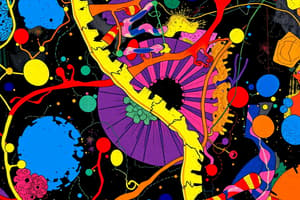Podcast
Questions and Answers
Which of the following is NOT one of the tenets of cell theory?
Which of the following is NOT one of the tenets of cell theory?
- Cells arise from pre-existing cells.
- The cell is the basic unit of structure and organization in organisms.
- All living things are made up of one or more cells.
- Cells can spontaneously generate from non-living matter. (correct)
What is the function of the cell membrane?
What is the function of the cell membrane?
It supports and protects the cell and controls the movement of substances in and out.
What is found in the cytoplasm?
What is found in the cytoplasm?
Cell organelles such as endoplasmic reticulum, vacuoles, mitochondria, ribosomes.
Which organelle is referred to as the 'powerhouse of the cell'?
Which organelle is referred to as the 'powerhouse of the cell'?
Lysosomes are known as the cell's 'suicide bags'.
Lysosomes are known as the cell's 'suicide bags'.
What role do chromosomes play in human cells?
What role do chromosomes play in human cells?
Who was the first to use the term 'cell'?
Who was the first to use the term 'cell'?
What is the primary organelle for photosynthesis?
What is the primary organelle for photosynthesis?
What do vacuoles store in plant cells?
What do vacuoles store in plant cells?
Match the following scientists with their contributions to cell theory:
Match the following scientists with their contributions to cell theory:
Flashcards are hidden until you start studying
Study Notes
Cell Theory
- Consists of three tenets:
- All living things are composed of one or more cells.
- The cell is the fundamental unit of structure and organization in organisms.
- Cells originate from pre-existing cells.
Cell Parts and Functions
-
Cell Membrane
- Supportive and protective outer covering of all cells.
- Regulates the movement of substances in and out.
- Also known as plasma membrane.
-
Cell Wall
- Exclusive to plant cells; protects the plasma membrane.
- Provides shape, structural support, and mechanical protection.
-
Cytoplasm
- Thick, jelly-like substance inside the cell membrane.
- Contains suspended organelles such as endoplasmic reticulum and mitochondria.
-
Nucleus
- Houses hereditary material (DNA) and sends growth and division signals.
- Surrounded by a nuclear envelope for protection.
-
Nucleolus
- Site of ribosome synthesis, also involved in cellular activity and reproduction.
-
Nuclear Membrane
- Forms a boundary separating the nucleus from other organelles, safeguarding the nucleus.
-
Chromosomes
- Crucial in determining individual sex, with 23 pairs present in human cells.
-
Endoplasmic Reticulum
- Transports substances and is involved in carbohydrate metabolism, lipids, steroids, and protein synthesis.
-
Golgi Bodies
- Known as the cell's post office; involved in material transportation within the cell.
-
Ribosome
- Responsible for protein synthesis in the cell.
-
Mitochondria
- Known as the powerhouse of the cell due to ATP production for energy.
-
Lysosomes
- Engulf foreign bodies and facilitate cell renewal, termed "suicide bags" for their role in digestion.
-
Peroxisomes
- Contain enzymes for oxidizing fatty acids and amino acids, generating potentially toxic hydrogen peroxide.
-
Chloroplast
- Primary organelle for photosynthesis; contains chlorophyll pigment.
-
Vacuoles
- Store food, water, and waste materials; larger in plant cells.
Key Features in Animal and Plant Cells
- Both contain mitochondria, vacuoles, and a cell membrane.
Contributors to Cell Theory
-
Robert Hooke
- First to use the term "cell" in 1665 after observing cork under a microscope, comparing it to a honeycomb structure.
-
Matthias Schleiden
- German botanist stating that plant tissues are made of cells (1838); proposed cells formed through crystallization.
-
Theodor Schwann
- Noted that animal tissues are also made of cells, contributing to the overall understanding of the cell theory.
Studying That Suits You
Use AI to generate personalized quizzes and flashcards to suit your learning preferences.




